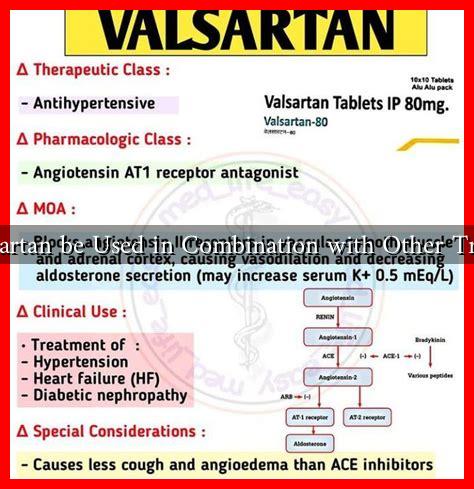-
Table of Contents
Can Valsartan be Used in Combination with Other Treatments?
Valsartan, an angiotensin II receptor blocker (ARB), is primarily used to treat high blood pressure and heart failure. It works by relaxing blood vessels, which helps to lower blood pressure and improve blood flow. However, many patients often wonder whether valsartan can be safely combined with other treatments. This article explores the potential benefits and risks of using valsartan in combination with other medications, as well as the conditions under which such combinations may be effective.
Understanding Valsartan
Valsartan is commonly prescribed for:
- Hypertension (high blood pressure)
- Heart failure
- Post-myocardial infarction (heart attack) management
As an ARB, valsartan blocks the action of angiotensin II, a hormone that causes blood vessels to constrict. By inhibiting this hormone, valsartan helps to lower blood pressure and reduce the workload on the heart.
Combination with Other Antihypertensives
One of the most common scenarios for using valsartan in combination therapy is in the management of hypertension. Combining valsartan with other antihypertensive medications can enhance blood pressure control. Some effective combinations include:
- Valsartan and Hydrochlorothiazide: This combination is often used to treat patients whose blood pressure is not adequately controlled with valsartan alone. Hydrochlorothiazide is a diuretic that helps to eliminate excess fluid and sodium from the body.
- Valsartan and Amlodipine: Amlodipine is a calcium channel blocker that can further lower blood pressure by relaxing blood vessels. This combination is particularly effective in patients with resistant hypertension.
Studies have shown that these combinations can lead to significant reductions in blood pressure compared to monotherapy. For instance, a study published in the Journal of Hypertension found that patients receiving valsartan and hydrochlorothiazide experienced a greater decrease in systolic and diastolic blood pressure than those on valsartan alone.
Valsartan in Heart Failure Management
In patients with heart failure, valsartan is often used in conjunction with other medications such as:
- Beta-blockers: These medications help to reduce heart rate and improve heart function. The combination of valsartan and beta-blockers has been shown to improve outcomes in heart failure patients.
- Aldosterone antagonists: Medications like spironolactone can be used alongside valsartan to further reduce mortality and morbidity in heart failure patients.
A clinical trial known as the PARADIGM-HF study demonstrated that the combination of valsartan and sacubitril (a neprilysin inhibitor) significantly reduced the risk of cardiovascular death and hospitalization for heart failure compared to enalapril, an ACE inhibitor.
Potential Risks and Considerations
While combining valsartan with other treatments can be beneficial, it is essential to consider potential risks:
- Hyperkalemia: Combining valsartan with other medications that increase potassium levels (like potassium-sparing diuretics) can lead to dangerously high potassium levels.
- Hypotension: The risk of low blood pressure increases when valsartan is combined with other antihypertensives, especially in elderly patients or those with volume depletion.
- Renal function: Patients with pre-existing kidney issues should be monitored closely when valsartan is used in combination with other medications that affect renal function.
Conclusion
Valsartan can be effectively used in combination with other treatments, particularly for managing hypertension and heart failure. The right combinations can enhance therapeutic outcomes and improve patient quality of life. However, it is crucial for healthcare providers to carefully evaluate each patient’s individual circumstances, monitor for potential side effects, and adjust treatment plans accordingly. As always, patients should consult their healthcare providers before making any changes to their medication regimens.
In summary, while valsartan is a powerful medication on its own, its efficacy can be significantly enhanced when used in combination with other treatments, provided that careful consideration is given to potential risks and patient-specific factors.

